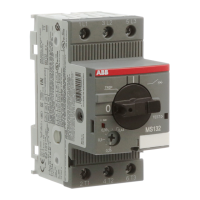MANUAL MOTOR STARTER GUIDE
APRIL 19 41/ 80
3.4 Lamps and lighting loads
Two lamp-specific utilization categories exist: AC-5a for electric discharge (florescent) lamps, and AC-5b for incan-
descent lamps, both of which have been fully harmonized. ABB has special lamp starters that are suitable for the
manual control of lamp loads. The table below shows the correlation between these ratings and a variety of commer-
cially available lamps.
Compact fluorescent lamps
Florescent lamps with electronic ballast
1)
Halogen electric light bulbs
Halogen metal vapor lamps
High-pressure discharge lamps
Incandescent (filament) light bulbs
Mercury vapor high-pressure lamps
Sodium vapor high-pressure lamps
Table 12: Lamps and lighting loads.
3.5 Transformers
A transformer is a passive electrical device designed to change one voltage to another. Therefor the ABB has built a
version of Manual motor starters MS132-T, this suitable for control and protection of control transformers.
3.5.1 Primary-side protection of transformers
For the primary-side protection of transformers, the inrush current of an open-circuiting transformer must be con-
sidered. Here, due to the supersaturation of the iron core, a high magnetizing current, which may be 15 to 20 times
the rated transformer current occurs, and typically lasts for a period of up to 40 ms.
The power-on spikes will clear within a few milliseconds, but may trigger the short-circuit release, especially on fast,
high-current-limiting circuit-breakers. Slow circuit-breakers are better suited here, especially if the short-circuit re-
lease range can be adjusted and set to a higher value, or a direct release via short delay is possible.
Manual motor starters (only the MS132-T and MS132-KT) for transformer protection are electromechanical protection
devices specially designed to protect control transformers on the primary side. They allow fuse less protection
against overload and short-circuits saving space and cost and ensuring a quick reaction under short-circuit condi-
tions by switching off the transformer within milliseconds. Additional the devices allow manual connection and
disconnection of the transformer from the mains.
3.5.2 Secondary-side protection of transformers.
Similarly to motors, transformers are overloadable, depending on the previous continuous power and the coolant
temperature. Transformers are less sensitive to short-term overloads such as motors. Although circuit-breakers offer
too much protection against thermal overload, they are nevertheless well suited for transformer protection.
For the secondary-side protection of transformers, circuit-breakers are used which have a switching capacity equal
to or greater than the transformer short-circuit current. The thermal overload release of the circuit-breaker needs to
be set to the rated transformer current.
Short circuit protection is provided by instantaneous electromagnetic releases. For selectivity tasks for the down-
stream short-circuit protection devices, circuit-breakers with short overcurrent release times need to be provided.

